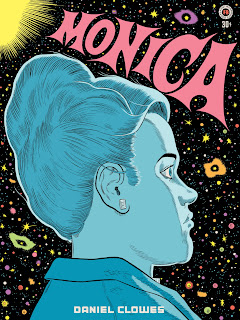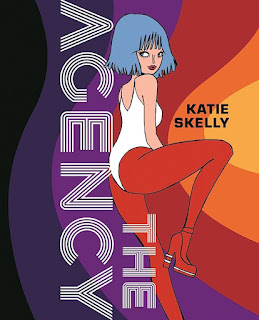Fall Through by Nate Powell
This book is already dancing about architecture. So I worry that anything I might say would compound that – painting a picture of dancing about architecture. But here I am, and here I go.
Fall Through is Nate Powell’s new graphic novel this year: it has what I think of as his trademark atmospheric, black-background, swirling pages and vaguely creepy, unexplained and deeply embedded fantasy elements. I found myself resisting it more than some of his earlier books: as always, I can only say how I reacted, and note that it’s as likely to have been me as the book.
This is the story of a punk band, Diamond Mine. They formed in 1994, recorded a 7″, did a bunch of touring, had a following. They lived together in a house, all seemingly in their early twenties. They were part of a wider punk scene across the Midwest and South, with clusters of more-or-less angry, more-or-less young people in every mid-sized town or larger, putting on mostly illegal shows in fields or backyards or wherever and running away when the cops came to break it up. None of that paid – if you actually made gas money, you were way ahead.
Punk, you know?
Jody was one of the four members of the band. She played bass and sang, at least some of the time. She wasn’t the leader and songwriter: that was Diana. She wasn’t the flashy guitarist: that was Napoleon. She wasn’t the quiet, solid-as-a-rock drummer: that was Steff. But she’s our viewpoint character.
Fall Through takes place mostly in 1994. But we also see Jody, seeming the same age, or just a few years younger, in 1978, back in what Gen X me thinks of as the actual age of punk. (Punk was a movement. It happened, and ended, like every other movement. Even early ’80s hardcore was something else. Everything later was revivals and different things, just like “rockabilly” now isn’t what it meant in the ’50s.)
How did Jody get from being 18ish in 1978 to being 23ish in 1994? Well, that’s the story here.
Most of the book is about a tour. It’s the summer of 1994, and the four members of Diamond Mine are in a van, going from town to town to play shows with local acts – again, mostly not legally, and the only way they get paid is if they sell some merch. Like any tour, it seems to be endless, days stretching on and on, each one like the last. Like it never began and will never end, just a single day, over and over again.
And that may be true. Diana wrote a song – “Fall Through” – and when Diamond Mine plays it the right way, at the climax of a show, they seem to change worlds or times or something. The flap copy calls it “transported to alternate worlds in which they’ve never existed but their band’s legend has.” I don’t know about that: it all seems to still be 1994, and they have tour dates day after day, which implies their band exists and is known.
Really, it feels like a reset. Maybe different worlds, but not that different from each other. Certainly not the wild swings in time and space the description implies. All still that same tour, the same van, rambling through mid-America during the summer of 1994. More punk shows: one every night, potentially forever. Like August keeps resetting – this time St. Louis, the next time Louisville.
Diana seems to be doing this on purpose. Once there’s a frightening figure – coming out of a surrounding cornfield, like a horror movie, during their set – that she clearly triggers the song, the spell to get away from. And it’s taken a while, but the rest of the band knows something is wrong.
There are confrontations, but it’s all in vague language – “moving forward,” “sticking together,” that kind of thing. I expect punks to be louder, more demanding – to swear a lot more, for one thing. (I guess these are well-behaved, Southern, second generation punks.)
So the book never explains what’s happening or why. They talk around it a few times, but that’s all. There’s never even a “this band is going to break up” fight or possibility or option: it’s as if they’re all locked into this, no matter what they want or choose.
The situation does get resolved in the end, and we do circle back to 1978…but the ways and hows of it frustrated me. It’s all thematically appropriate, but not dramatically. The plot doesn’t go anywhere, the actions of the characters aren’t really important to the ending. It’s a book about an endless punk tour, about community and scene, rather than being a story about these things that happened to these people.
We never learn why this happened. We never learn how this song works. We never learn who that mysterious figure was, if he was actually chasing them, or anything. In the end, it all doesn’t matter, all those explanations are beside the point Powell wants to make. But I was here to find out all those things, and I don’t have any particular nostalgia for “wasn’t it awesome to be young and in a punk band?”
So I found this book incredibly frustrating: it avoided all of the things I wanted to know and focused entirely on things I found vague and trite. It’s lovely and thoughtful: Powell draws as well as ever and his people are real and precise. They just all waffle on about the least interesting things, and then go on to play another show as if none of that happened, which makes very little sense to me.
Your mileage may vary. If you’ve ever been in a band, particularly. And Powell is one of our best, so I won’t ignore the fact that I might have missed something major. But the Fall Through I read was not the book I was hoping for.
Reposted from The Antick Musings of G.B.H. Hornswoggler, Gent.





















